
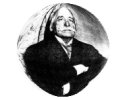
|
CULINARY INFO
|
"DISCLAIMER"
|
My day spent with Michel Escoffier,
Auguste's Great Grandson and Vice President of the Escoffier Musuem and Foundation
CLICK HERE
At the beginning of Escoffier's career, cooking was not a profession held in high esteem. This was due partly to the laxity which could so easily creep in and also to the rigorous conditions of work. The cook spends the greater part of his time around the stove in overwhelming heat and in the midst of the smell of cooking, which, when concentrated, is sometimes almost unbearable. He works continuously without a moment's respite. For these reasons, in the mid-nineteenth century drinking was inevitably rife in the kitchen. Escoffier was quick to realise the risks in giving way to such excesses. The cuisine of course suffered, the atmosphere in the kitchen suffered and the appearance of certain old cooks, undermined by years of work in such conditions and by their intemperance, gave hims food for thought. He, with his small stature, was destined to suffer even more than others from the heat of the stoves. However, he never allowed himself to drink or smoke. He made it a point of honour to preserve his impeccable taste.
Later, when he had become a chef, he called upon a famous doctor to invent a pleasant and healthy drink which would relieve the discomfort of cooks working in such conditions. Thus in all the hotel kitchens which he planned, there was always a vast kettle containing a barley drink. This allowed Escoffier to prohibit the drinking of alcohol in the kitchen. Swearing and shouting were the norm then as was the brutal treatment of young apprentices. Escoffier fought first against professional slang and vulgarity of speech. Swearing and vulgar display of temper were no longer allowed and on his insistance there were to be no swearing and brutality of apprentices (as was the norm) and more thirst quenching drinks(non-alcoholic) were made available to combat the heat. He himself would leave the kitchen rather than lose his temper with the staff.
Escoffier also insisted on the cleanliness of his employees during working hours, and also encouraged them to dress and behave better outside. He was concerned too, with his employee's educational status, and advised them to acquire the culture which their professional training (often started at a very early age), had prevented them from attaining.
The kitchen brigade as we know it of Chef de parties etc was a system devised and implemented by Escoffier. Kitchens had for centuries been seperated into sections, but it was August who devised an organised system, to ensure there was no doubling up work and things were properly organised. Escoffiers kitchens were said to be well run and organised. Escoffier introduced the genuine frying-pan into English life.
He was also responsible for simplifying menus, instead of vast arrays of dishes served all at once; Service à la Française (as was the practice), it was Escoffier that wrote them down and served in the order they appeared; Service à la Russe. So simple an idea really, it is strange t think it was not the norm. That said of course, as in Chinese cuisine there is a place for banquet style service or Service à la Française
What is not widely known about Escoffier is the how much of a humanitarian he was. The following was told to me by the man's great grandson when I met and spent the day with him recently (January 2008)
"The humanitarian aspect is what I insist on today. People know him as a great chef and organiser, but they don't know he was a great humanitarian, concerned with the welfare of chefs and the poor. He was the first to create fundraising dinners for chefs who were sick or retiring and so on, and there are many other stories of his efforts.
"When he was at the Savoy with Caesar Ritz, he would collect all the supplies that were not served and, rather than throw them away, he put this out every morning and the nuns of the Little Sisters of the Poor would come and collect these things with a horse- drawn carriage – this is about 1891-92. One morning they did not show up. He went to see the Mother Superior and learned the horse had died and they did not have the five pounds to buy another, and five pounds was certainly a lot of money then. So that night a young commis chef from the Savoy showed up at the Little Sisters of the Poor with an envelope with five pounds in it.
"He continued (giving unused supplies to the poor) at the Carlton when he took over. He was there for 20 years, until he retired. Later, he was very sad to find that his successors had not continued the practice."
This page and research has been completed with great thanks and assistance of trainee chef Ms Ash Briggs
Chef Auguste Escoffier to many, took over the mantle of Antoine Careme. Escoffier took over from where Careme left off; taking the old styles and cuisines and not only re-invented them, but putting his own mark on them also. Redisigning kitchens and the way the chefs of the day worked, by creating the brigade system in use today and the way staff were treated.
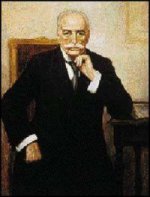

Escoffier : A Brief Biography
1846:
George Auguste Escoffier was thought to have been born on the 28th October 1846, in Villeneuve Loubet, a village which nestles peacefully below its mediaeval castle, in the neighbourhood of Nice, in the Provence region, and died February 12, 1935. He modernised and simplified the more elaborate cuisine of the 18th-century master chef, Marie Antoine CAREME.
As a young boy, he grew up in happy family surroundings. His father was a blacksmith and he also grew tobacco plants. He was known to be good-humoured, strong and a pleasing man. His fine physique, slim, strong body and open smiling face conveyed a feeling of health and friendliness which made him popular with everyone.
Up to the age of twelve, Auguste went to the local school. The enthusiasm which he showed for drawing and everything which gave him the opportunity to interpret the beauty around him seemed to indicate the vocation of an artist. But the child's future was to be very different. Perhaps it was the personality of the boy's grandmother that we must recognise to be one of the factors determining his future. Auguste loved and admired his grandmother, and perhaps it was at play in her kitchen that the desire was born to devote his life to the creation of artistic delicacies.
1859 :
Escoffier was thirteen years old and the time had come for him to learn a trade. "By all means let him devote his leisure time to art, but whoever made a living by it?" This reasoning, full of peasant good sense, was what prompted Escoffier's father to take the boy to Nice, where his brother had opened 'Le Restaurant Francais'. Auguste's uncle had succeeded in establishing a reputation for his restaurant which was to last until 1910.
Life was hard in the kitchens in those days, all the more so, for an apprentice and his uncle granted Auguste no special favours. Apart from the work of the kitchen, he was initiated into all the household tasks. He knew how to select and buy provisions as well as organise the service. Escoffier always remembered with gratitude the strict discipline and severity of his early training.
1865 :
When he was nineteen, the chef of the Le Petit Moulin Rouge, (Ulysee Rohant) the most fashionable restaurant in Paris, noticed him during a stay in Nice and invited him to join his team, first as commis de rôtisseur and then Saucier There he stayed, but for a brief military training in 1866/7, until 1870. When the Franco-Prussian War broke out and he was recalled to the army.
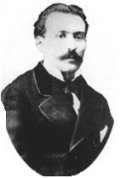
1870 :
He was appointed Chef de Cuisine at the fortress of Metz. There is no doubt that it was those days of siege which forced Escoffier to think so seriously about the necessity of preparing tinned food. He was the first chef to study thoroughly the technique of canning meat, vegetables and sauces.
With the defeat of the French, Escoffier (apparantly) became a war prisoner and eventually freed with the help of the general manager of the “Kursaal” in Wiesbaden (Germany). Escoffier served thereafter in the kitchen brigade under the well known General Mac – Mahon, who later became the president of the republic. (Webmaster note : I have not been able to verify this last paragraph)
1871 :
He returns to Paris as the Head Chef for Colonel Comte de Waldner
1872 :
He joins the “Hôtel du Luxembourg”, in Nice where he started his culinary career.
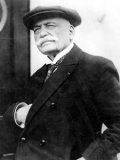
1873 :
Escoffier returned to the Le Petit Moulin Rouge after the war and remained their Head Chef until 1878. It said he took to wearing built up shoes so as to work better on the stoves (he was a man of diminitive size).
1876 :
He opens his own restaurant in Cannes; Le Faisan d'Or (The Golden Pheasant)
1878? :
Back in Paris, he either first worked as the Chef in the restaurant “Maire”, where Monsieur Paillard entrusted him with the management of his kitchens and then was appointed to the Management of the Maison Chevet, at the Palais Royal or Chevet and then Maire. Either way, this was an incredible achievement for someone so young of age (38)
The Maison Chevet was a very fashionable restaurant particularly for big dinners and official banquets. In fact Chevet was known to 'deliver' dinners complete with silver cutlery, chinaware and a brigade of chefs etc as far away as Saint Petersburg (Russia). They also were the first ones to serve dinner in the Eiffel Tower in 1898, a dinner which was hosted by nobody less than Mr. Eiffel himself.
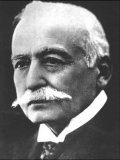
1880 :
The main event during this period was his marriage to Delphine Daffis, the daughter of a publisher.Writing poetry herself, she contributed to his first publication in book form entitled 'Les Fleurs en Cire' (Flowers in Wax) Escoffier wrote and published a great deal, and he is still consulted as an authority.
The best known culinary writings of Escoffier are :
1886 - Le Traite sur L'art de Travailler les Fleurs en Cire
1903 - Le Guide Culinaire
1910 - Les Fleurs en Cire (a new edition)
1911 - Le Carnet d'Epicure
1912 - Le Livre des Menus
1927 - Le Riz
1929 - La Morue
1934 - Ma Cuisine
Its written work is, without question, that of a man far in advance of his time, yet he never failed to acknowledge the contribution of his predecessors. And though circumstances later kept him and his wife apart for long periods, they remained profoundly devoted to one another until the very end, 55 years later. They had two sons and a daughter.
1884 :
They left for Monte Carlo, (city in Monaco on the Mediterranean Coast) where the gambling casino was enjoying rapidly growing fame. He was Directeur de Cuisine of the Grand Hotel and during the next six years divided his time between the Grand Hotel in Winter and the Hotel National in Lucerne, Switzerland, in the summer.
It was here that Escoffier met Cesar Ritz who came from a small village in the Swiss Valais. Ritz started as a hotel groom and rapidly worked his way up to head waiter and into Hotel Management. The mutual understanding and teamwork between and Ritz was to bring about the most significant changes and modern development in the hotel industry.

Cesar Ritz
1890 :
Along with Escanard, Escoffier and Ritz were called to the Savoy Hotel in London as General Manager and Head of Restaurant Services respectively. Their success was beyond expectation. Hotels all over the world grew out of this famous partnership. They included the Savoy and Carlton in London, the Grand Hotel, Rome. The Ritz Hotels in Paris, London, New York, Montreal, Philadelphia and many more. Many of the hotels throughout the world were established on the guarantee of their reputation, the very names Ritz and Carlton being synonymous with quality and a high degree of comfort.
Cesar Ritz and Escoffier, each in his own sphere, organised teams of first class workers who went out into all the corners of the world on ships and in hotels spreading the fame of French cuisine and comfort. Escoffier enjoyed considerable powers and had extensive means at his disposal, his role was both complex and difficult. Without losing sight of the commercial considerations involved, he was expected several times daily and at any hour to serve the kind of meals expected by a numerous and exigent clientele with very limited time to spare. It was essential to have some dishes prepared in advance for those who had not the time to wait. He had to keep in mind not only the short time allowed for the actual consumption of the meal, but also the often non-existent, time allowed by business men for the digestive process.
The work of the kitchen had to be so organised that the quality of the food was not impaired by the speed with which it had to be served or by the number of clients. Hygienic considerations had to be taken into account also, and, last but not least, in a country where the supply of provisions is often more difficult than in France, he had to organise a system of marketing which reconciled peerless quality with an economic price.
Each evening he had to think up new menus so as never to be found wanting by the gourmets attracted to the Savoy by his presence. Escoffier created many of his famous dishes in the honour of his guests, most notably:

One of the first menus composed by Escoffier was on the 16 December 1897.
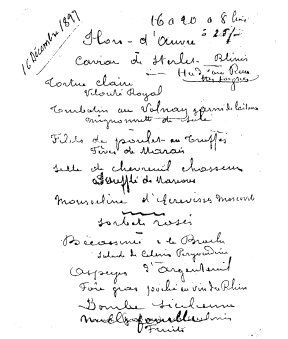
DISHES CEATED BY ESCOFFIER
Peach Melba,
In honour of the Australian Singer, Nellie Melba. During 1892 and 1893, Madame Melba lived at the Savoy Hotel. She was singing at Covent Garden Opera House, and Escoffier, who was passionately interested in the theatre, was an enthusiastic listener. The Majestic Swan which appears on the scene, gave him the idea of preparing a surprise for the brilliant singer. The following evening Melba had invited some friends to dinner. Taking advantage of this opportunity, Escoffier had peaches served on a bed of vanilla ice-cream in a metal dish, set between two wings of a magnificent swan, shaped out of a block of ice and covered with a layer of icing sugar.
lt was on the day of the opening of the Carlton Hotel, London, that Escoffier decided on the flavour which was to give this dessert its real claim to distinction. Out of the whole range of fruit flavours, he chose raspberry, thus "Peach Melba" officially came into being.
Melba Toast
Originally named Toast Marie, after the wife of Cesar Ritz.
Chaud - Froid Jeannette
In 1881 the Jeannette, a ship equipped for an expedition to the North Pole, became icebound. The whole crew died except two sailors who after repeated efforts managed to reach the Siberian coast.It was in memory of this expedition that Escoffier wanted to give the name of this ship to one of his greatest culinary successes "Les Supremes de Volailles Jeannette".
Cuisses de Nymphe Aurore :
a dish of frogs legs created for the Prince of Wales
Rejane Salad
Rachel Mignonettes of Quail :
In homage to two great actresses.
Tournedos Rossini :
Named after the great Italian composer, Gioacchino Rossini
Not to mention all the recipes of his we still use today, is it then no wonder he gained the title; King of Chefs' and Chef of the Kings'
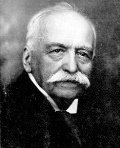
1898 :
Cesar and Escoffier opened the Hotel Ritz in Paris, which was the most modern of the time. It had electric lights, large bathrooms built into cupboards. A wine cellar that held 4000 bottles of vintage an da reserve cellar a few blocks away that held another 180,000 ! However at their instance the ovens were fired by coke or wood.
1899 :
The Carlton Hotel was opened in the very heart of London. The kitchens, administered by Escoffier who had a team of sixty cooks under his control, were so organised as to be able easily to serve menus a' la carte, a practice introduced for the first time at the Carlton. lt was not unusual, particularly on a Sunday to serve anything up to 500 clients at each meal. Escoffier was to spend more than twenty years there. In 1901 the team broke up when Cesar had a nervous breakdown (dying in 1918). Escoffier remained at the Carlton until 1919
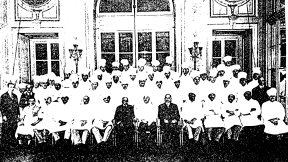
1902/3 :
Saw the publication of his book; Le Guide Culinaire, an amazing compendium of around 5000 recipes and garnishes. He was associated with E. Fetu and P. Traisneau in founding in 1903 l'Association Culinaire Francaise de Secours Muteuls, a friendly society for French cooks working in England.
1904 :
The German Shipping Company, Hamburg - Amerika Lines, decided to introduce an a' la carte restaurant service for the more illustrious of the passengers on their liners. The service was to be named "The Ritz Carlton Restaurants". Escoffier was invited to plan the kitchens.
Also around this time he was a consultant for the shipping line, which included the RMS Titanic The menu served on its final night as it sank was created by Escoffier Which is kind of ironic given the fact that one of his most famous dishes was served on an ice sockle
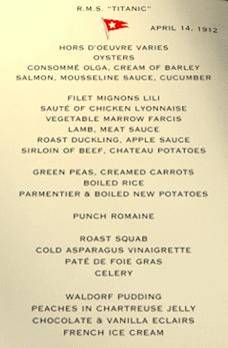
1912 :
Again the Hamburg - Amerika Shipping Line requested Escoffier's services for the inauguration of the kitchens. During the official trial cruise the Press gave it ample publicity. They headlined "Cuisine Hailed on Sea as on Land".
Aboard the liner Imperator shortly before the start of World War I, as the Larousse Gastronomique tells it. The Kaiser, Emperor William II, was so impressed with the job that the supervisor of the ship's imperial kitchens had done that he turned to him and said, "I am the Emperor of Germany, but you are the Emperor of chefs."
1914 :
Auguste Escoffier was sixty-eight years of age. He continued to direct the Carlton's kitchens. In spite of his small stature, he displayed the same energy and strength as had his father.
1919 :
At the age of seventy-three, Escoffier decided to leave the Carlton and to retire to Monte Carlo and rejoin his wife. Escoffier, however, could not adapt himself to retirement. At Monte Carlo he met once again the widow of his friend Jean Giroix, with whom he worked at the Petit Mouline Rouge, and whose place he had taken at the Grand Hotel, Monaco. Escoffier accepted her proposal that he should collaborate with her in the administration of the Hotel de I'Ermitage. He also assisted in the development of the Riviera Hotel in Upper Monte Carlo.
1920? :
On 22nd March, the Commander of the Legion of Honour and Director of Technical Education, conferred on Escoffier the Order of Officer of the Legion of Honour. Escoffier was the first chef to be honoured.
Escoffier often composed menus himself when he knew the clients. When he did not know them, the head waiter would give brief indications of their nationality, of how many men and how many women made up the party, and of any preferences they had disclosed. This information enabled Escoffier to adapt the menu to suit the guests.
Escoffier introduced notable changes also in the presentation of his dishes and even in the actual choice of china. His primary consideration was the comfort of the client. He chose finechina, silver, linen and glassware which enhanced the superb food and wine. He introduced the most practical of kitchen utensils and those best suited to the quality of the cuisine.
1928 :
Received the Rosette of an Officer of the Legion by the German Emperor William II.
1935 :
On the 12th February, a few short weeks after the death of his wife, Escoffier died in his home, La Villa Fernand, 8 bis Avenue de la Costa, Monte Carlo, in his eighty-ninth year. His remains are buried in the family vault at Villeneuve - Loubet. The house where he was born was transformed into a museum of culinary art in 1966, at the suggestion of one of his cooks.
Footnotes:
"I well remember a shooting party given by one of my friends who owned a vast property in an exquisite valley of the Haute-Savoie. My friend had chosen this domain so that he could go there from time to time, far from the irritations of a too active life. It was the beginning of November, a period when the shooting offers particularly attractive sport, especially in these rather wild districts. About ten guests were assembled on the Thursday evening, and it was decided that at dawn the following morning we should all set out, dispersing as chance directed, in search of a few coveys of partridge. Our meal, that evening, was composed of a cream of pumpkin soup with little croutons fried in butter, a young turkey roasted on the spit accompanied by a large country sausage and a salad of potatoes, dandelions and beetroot, and followed by a big bowl of pears cooked in red wine and served with whipped cream. Next morning at the agreed hour, we were all ready, and furnished with the necessary provisions and accompanied by local guides, we climbed the rocky paths, real goat tracks, without too much difficulty and before long the fusillade began. It was those members of the party who had gone ahead who were opening the shoot by bagging two hares; the day promised to be fairly fruitful. And indeed so it turned out, since we were back at the house by about four o'clock, somewhat tired, but proud to count out: three hares, a very young chamois, eleven partridges, three capercailzies, six young rabbits, and a quantity of small birds. After a light collation, we patiently awaited dinner contemplating the while the admirable panorama which lay before us. The game which we had shot was reserved for the next day's meals.
Our dinner that evening consisted of a cabbage, potato, and kohlrabi soup, augmented with three young chickens, an enormous piece of lean bacon, and a big farmhouse sausage. The broth, with some of the mashed vegetables, was poured over slices of toast, which made an excellent rustic soup. What remained of the vegetables were arranged on a large dish around the chickens, the bacon, and the sausage; here was the wherewithal to comfort the most robust of stomachs, and each of us did due honour to this good family dish.To follow, we were served with a leg of mutton, tender and pink, accompanied by a puree of chestnuts. Then, a surprise-- but one which was not entirely unexpected from our host, who had an excellent cook--an immense, hermetically sealed terrine, which, placed in the middle of the table, gave out, when it was uncovered, a marvelous scent of truffles, partridges, and aromatic herbs. This terrine contained eight young partridges, amply truffled and cased in fat bacon, a little bouquet of mountain herbs and several glasses of fine-champagne cognac. All had been lengthily and gently cooked in hot embers. At the same time was served a celery salad. As for the wines, we had first the excellent local wine, then Burgundy, and finally a famous brand of champagne. The dinner ended with beautiful local fruit, and fine liqueurs.
The next day's luncheon was composed partly of the trophies of the previous day's shooting; the pure mountain air had advantageously taken the place of any aperitif; nor did we have any hors-d'oeuvre but instead, some char from the lac du Bourget, cooked and left to get cold in white wine from our host's own vineyards. These were accompanied by a completely original sauce, and here is the recipe: Recipe: Grated horseradish, mixed with an equal quantity of skinned walnuts finely chopped; a dessertspoon of powdered sugar, a pinch of salt, the juice of two lemons, enough fresh cream to obtain a sauce neither too thick nor too liquid. We all carried away with us the happiest memory of this beautiful country of Savoie and of the very hospitable welcome which we had received. For my part, I have never forgotten the sauce of horseradish and walnuts."
Le Feu Sacre - The Virtual Kitchen

